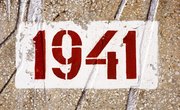
Guns made prior to 1899 are considered antique. Parts of an antique gun include the band, barrel, bridle, butt plate, cylinder, entry pipe, escutcheon, extractor, firing pin, frame, hammer, hand, hinge, lever, link, lock, lock plate, main, nose cap, pan, pin, plunger, ramrod, receiver, ring, screw, sear, side plate, sight, sight leaf, sling, sling swivel, spring, stock, tang, top jaw, trigger, trigger guard, tube, tumbler and washer. Depending on the maker of the gun, some antique gun parts were marked and some were not but there are certain parts that were generally marked in a similar way by various antique gun manufacturers that mass-produced firearms.
Items you will need
Magnifying glass
Look on either side of the chamber of the antique gun. The chamber is the part of the gun that receives the charge for firing. Serial marks may be stamped on the chamber on antique guns.
Examine the buttplate or buttstock. On antique guns, the buttplate or buttstock was sometimes made from wood, as in the case of Civil War-era guns. The buttplate or buttstock is the section often stamped with a maker's mark or name.
Look closely at the parts that hold the gun together. For example, on old Remington gun made with wooden buttstocks, there are old screws that are sometimes marked with makers marks or symbols used by the company as a copyright mark.
Look at the receiver. The receiver is the part of the gun considered the frame or the body of the gun itself. On antique receivers, the serial numbers may be found on the side of the gun body.
Check the barrel on antique guns. Generally, the barrel may have the model number of an antique gun and old Winchesters in particular had markings on the barrel part identifying the type of gun model.
Warnings
- If an antique gun has a chamber and trigger still attached to the frame of the gun, make sure to point the gun away from you and anyone else and dislodge any old bullets from the chamber.
References
Warnings
- If an antique gun has a chamber and trigger still attached to the frame of the gun, make sure to point the gun away from you and anyone else and dislodge any old bullets from the chamber.
Writer Bio
Linda Stamberger began writing professionally in 1994, as an entertainment reporter for "Good Times Magazine." She has written online copy for The Volusia Community website and is the author of "Antiquing in Florida." Stamberger studied creative writing at Southampton College, where she won a partial writing scholarship.



